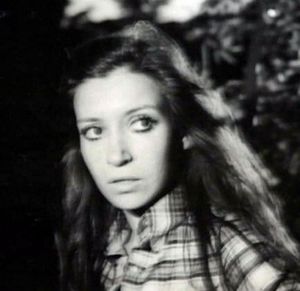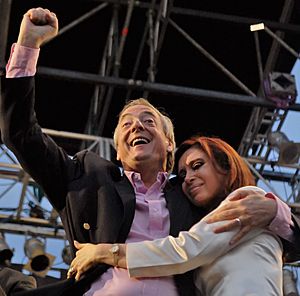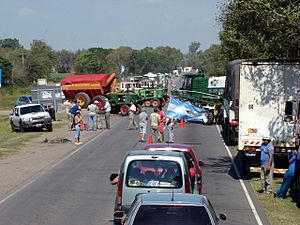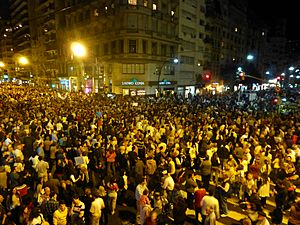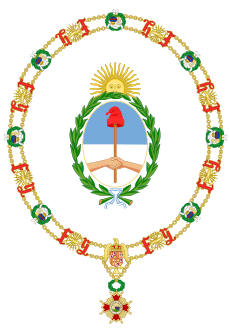Cristina Fernández de Kirchner facts for kids
Quick facts for kids
Cristina Fernández de Kirchner
|
|||||||||||||||||||||||||||||||||||||||||
|---|---|---|---|---|---|---|---|---|---|---|---|---|---|---|---|---|---|---|---|---|---|---|---|---|---|---|---|---|---|---|---|---|---|---|---|---|---|---|---|---|---|

Fernández de Kirchner in 2022
|
|||||||||||||||||||||||||||||||||||||||||
| President of the Justicialist Party | |||||||||||||||||||||||||||||||||||||||||
| Assumed office 17 November 2024 |
|||||||||||||||||||||||||||||||||||||||||
| Vice President | José Mayans | ||||||||||||||||||||||||||||||||||||||||
| Preceded by | Alberto Fernández | ||||||||||||||||||||||||||||||||||||||||
| 56th President of Argentina | |||||||||||||||||||||||||||||||||||||||||
| In office 10 December 2007 – 10 December 2015 |
|||||||||||||||||||||||||||||||||||||||||
| Vice President |
|
||||||||||||||||||||||||||||||||||||||||
| Preceded by | Néstor Kirchner | ||||||||||||||||||||||||||||||||||||||||
| Succeeded by | Mauricio Macri | ||||||||||||||||||||||||||||||||||||||||
| 37th Vice President of Argentina | |||||||||||||||||||||||||||||||||||||||||
| In office 10 December 2019 – 10 December 2023 |
|||||||||||||||||||||||||||||||||||||||||
| President | Alberto Fernández | ||||||||||||||||||||||||||||||||||||||||
| Preceded by | Gabriela Michetti | ||||||||||||||||||||||||||||||||||||||||
| Succeeded by | Victoria Villarruel | ||||||||||||||||||||||||||||||||||||||||
|
|||||||||||||||||||||||||||||||||||||||||
|
|||||||||||||||||||||||||||||||||||||||||
| Personal details | |||||||||||||||||||||||||||||||||||||||||
| Born |
Cristina Elisabet Fernández
19 February 1953 La Plata, Buenos Aires, Argentina |
||||||||||||||||||||||||||||||||||||||||
| Political party | Justicialist | ||||||||||||||||||||||||||||||||||||||||
| Other political affiliations |
|
||||||||||||||||||||||||||||||||||||||||
| Spouse | |||||||||||||||||||||||||||||||||||||||||
| Children | 2, including Máximo | ||||||||||||||||||||||||||||||||||||||||
| Alma mater | National University of La Plata | ||||||||||||||||||||||||||||||||||||||||
| Occupation |
|
||||||||||||||||||||||||||||||||||||||||
| Signature | |||||||||||||||||||||||||||||||||||||||||
Cristina Elisabet Fernández de Kirchner (born 19 February 1953) is an Argentine lawyer and politician. She served as the 56th President of Argentina from 2007 to 2015. Later, she became the 37th Vice President of Argentina from 2019 to 2023, serving under President Alberto Fernández. She was also the First Lady when her husband, Néstor Kirchner, was president from 2003 to 2007.
Cristina Fernández de Kirchner was the second woman to become president of Argentina. She was the first woman to be directly elected to this high office. Her political ideas are part of Peronism and Progressivism, and her specific approach is known as Kirchnerism. Since 2024, she has been the president of the Justicialist Party, which is a major opposition party in Argentina.
Contents
Cristina Fernández de Kirchner: A Leader's Journey
Early Life and Education
Cristina Fernández was born on 19 February 1953 in Tolosa, a town near La Plata, the capital of Buenos Aires Province. Her parents were Eduardo Fernández and Ofelia Esther Wilhelm. She attended high school at Popular Mercantil and Misericordia schools. Her grandparents came from Galicia, Spain.
She started her university studies at the National University of La Plata. She first studied psychology for a year, then switched to law. In 1973, she met Néstor Kirchner, who was also a student. He introduced her to political discussions. At that time, Argentina was going through big political changes. She became interested in Peronism, left-wing politics, and anti-imperialism. Cristina and Néstor got married on 9 May 1975.
Starting a Political Career
Cristina and Néstor Kirchner moved to Río Gallegos, Santa Cruz, Néstor's hometown. Cristina finished her law studies through distance learning. She became a lawyer and worked for the Justicialist Party.
In 1989, Cristina Kirchner was elected as a deputy for the provincial legislature of Santa Cruz. She even served as interim governor of Santa Cruz for a few days in 1990. In 1991, she helped with Néstor's political campaign when he was elected governor of Santa Cruz. In 1994, she was part of the group that updated the Constitution of Argentina.
She was elected as a national senator in 1995. She sometimes disagreed with proposed laws. She was known for speaking her mind. In 1997, she resigned from her senator seat and ran for national deputy instead. She was re-elected as a senator in 2001.
When Néstor Kirchner became president in 2003, Cristina became the First Lady. She continued her work in Congress. In 2005, she ran for senator for Buenos Aires province and won.
Becoming President
First Term as President (2007-2011)
In 2007, Néstor Kirchner decided not to run for re-election. Instead, Cristina Fernández de Kirchner became the candidate for the Front for Victory party. She won the presidential election in the first round with over 45% of the votes. She was very popular among working-class people and those in rural areas.
She officially became president on 10 December 2007. Her first term faced challenges like rising prices, public safety concerns, and issues with energy. She was the second woman to be president of Argentina, but the first to be directly elected by the people. Her husband, Néstor Kirchner, remained an important influence during her presidency.
Second Term as President (2011-2015)
After her husband Néstor Kirchner passed away in 2010, Cristina Fernández de Kirchner decided to run for a second term. On 21 June 2011, she announced her candidacy. She was re-elected in the 2011 general election with a large majority of 54.11% of the votes. This was one of the biggest wins in Argentine presidential elections since 1983. Her party also gained more seats in Congress.
Economic Changes
When she started her first term, Cristina Kirchner changed the Minister of Economy. Her government faced debt payments and decided to take over private pension funds. This meant the government would manage these funds. She said this was to protect people during a financial crisis.
In 2009, her government started the Universal Child Allowance. This program gives money to parents who are unemployed or work in the informal economy to help fight poverty.
During her second term, the government put in place currency controls. These controls limited how much foreign money, especially US dollars, people could buy or sell. This was done to stop money from leaving the country and to prevent tax evasion. In 2014, Argentina faced a sovereign default (meaning it couldn't pay its debts).
Energy and Public Services
For many years, prices for public services like electricity and gas were kept low by the government. This meant the government paid part of the cost through subsidies. However, this led to less investment in these services. Argentina started needing to import energy instead of producing enough for itself.
In 2012, she proposed removing some of these subsidies, but it was not popular. Instead, she decided to bring the energy company YPF back under government control. This company had been privatized in 1993. This decision was made because of the country's energy needs.
Farmers' Protests
In March 2008, Cristina Fernández de Kirchner's government introduced a new tax system for farm exports. This system would change taxes based on international prices. This meant higher taxes on products like soybean. Farmers across the country protested this new tax, blocking roads and causing food shortages.
The government said the new taxes would help share wealth more fairly and keep food prices down. Farmers argued that the high taxes made it hard for them to make a living. After four months of protests, the bill was put to a vote in Congress. The vote ended in a tie, and the Vice President, Julio Cobos, cast the deciding vote against the bill, which meant it was rejected.
Public Demonstrations
After her re-election in 2011, some of her supporters suggested changing the Constitution to allow presidents to be re-elected indefinitely. This idea was not popular with many people. In September 2012, a large protest called a cacerolazo (where people bang pots and pans) took place. People protested various issues, including rising crime rates and currency controls.
Another even larger protest happened two months later, with nearly half a million people attending. They protested inflation and other concerns. Cristina Fernández de Kirchner said she would continue with her policies.
In April 2013, floods in Buenos Aires and La Plata caused many deaths. Later, the government proposed changes to the justice system. These changes were seen by some as an attempt to control the courts.
International Relations


Cristina Fernández de Kirchner was part of a group of left-leaning presidents in Latin America during the 2000s, often called the "pink tide". She supported leaders like Hugo Chávez and Nicolás Maduro from Venezuela. She also worked to strengthen ties within the Mercosur trade bloc.
Her relationship with the United States was sometimes difficult. In 2012, on the 30th anniversary of the Falklands War, she spoke strongly about Argentina's claim to the Falkland Islands.
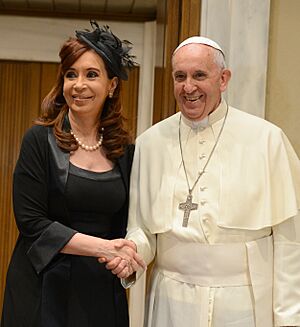
When Archbishop Jorge Bergoglio from Argentina was elected as Pope Francis in 2013, initial reactions were mixed. However, due to the Pope's popularity, Cristina Fernández de Kirchner quickly improved her relationship with him. They had a private meeting, which was the new Pope's first meeting with a head of state.

In 1994, a Jewish center in Buenos Aires, AMIA, suffered a terrorist attack. The investigation into this attack continued for many years. In 2015, a prosecutor named Alberto Nisman accused Cristina Fernández de Kirchner of trying to cover up the attack. He was found dead in his home the day before he was supposed to explain his accusation to Congress. This case caused a lot of controversy and remains unresolved.
After the Presidency
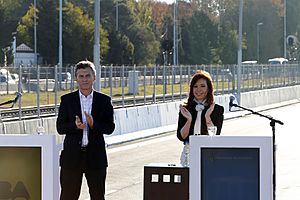
In the 2015 presidential election, Mauricio Macri was elected president. There were some disagreements during the transition of power. Cristina Fernández de Kirchner did not attend the handover ceremony, which was unusual.
After leaving the presidency, she founded a think tank called Patria Institute in 2016. She also wrote a book called Sinceramente (meaning "Sincerely"), which was published in 2019.
Senator and Vice President
In the 2017 midterm elections, Cristina Fernández de Kirchner ran for senator for Buenos Aires Province. She won a seat in the Senate, even though her party came in second place in the election.
On 27 October 2019, she was elected vice president of Argentina. She ran alongside Alberto Fernández (who is not related to her), who became president. This made her the first former head of state to become vice president in Argentina. She resigned from the Senate in November 2019 to take on her new role.
Legal Challenges
After leaving the presidency in 2015, Cristina Fernández de Kirchner faced several legal cases. In December 2022, she was found guilty of "fraudulent administration" related to public works contracts. The court sentenced her to six years in prison and a lifetime ban from holding public office. This verdict was upheld by an appeals court in November 2024 and by the Supreme Court in June 2025. She was allowed to serve her sentence at her private home. She has always denied the accusations against her.
In December 2024, the Supreme Court confirmed that she will have a trial for the case related to the memorandum with Iran, which was part of the investigation into the 1994 AMIA bombing. In March 2025, the US State Department placed an entry ban on her and a former minister for "significant corruption" during their time in office.
Personal Life and Health
In 1973, while studying at university, Cristina met Néstor Kirchner. They married in 1975 and had two children: Máximo (born 1977), who is now a National Deputy, and Florencia (born 1990).
Néstor Kirchner passed away on 27 October 2010. After his death, Cristina wore black for more than three years.
Her health has sometimes been a public topic. In 2011, she was diagnosed with thyroid cancer and had surgery in January 2012. After the operation, it was found that she had been misdiagnosed and did not have cancer. In October 2013, doctors found blood on her brain from an old head injury. She had successful surgery to remove the blood. In November 2021, she had a successful surgery for a uterine polyp.
Electoral History
Presidential Elections
| Election | Office | List | Votes | Result | Ref. | |||
|---|---|---|---|---|---|---|---|---|
| Total | % | P. | ||||||
| 2007 | President of Argentina | Front for Victory | 8,652,293 | 45.28% | 1st | Elected | ||
| 2011 | Front for Victory | 11,865,055 | 54.11% | 1st | Elected | |||
| 2019 | Vice President of Argentina | Frente de Todos | 12,946,037 | 48.24% | 1st | Elected | ||
Legislative Elections
| Election | Office | List | # | District | Votes | Result | Ref. | |||
|---|---|---|---|---|---|---|---|---|---|---|
| Total | % | P. | ||||||||
| 1989 | Provincial Deputy | Santa Cruz Victory Front | 1 | Santa Cruz Province | 11.969 | 36.81% | 1st | Elected | ||
| 1993 | Santa Cruz Victory Front | 1 | Santa Cruz Province | 26,877 | 69.32% | 1st | Elected | |||
| 1997 | National Deputy | Justicialist Party | 1 | Santa Cruz Province | 46,885 | 59.69% | 1st | Elected | ||
| 2001 | National Senator | Justicialist Party | 1 | Santa Cruz Province | 52,499 | 61.91% | 1st | Elected | ||
| 2005 | Justicialist Party | 1 | Buenos Aires Province | 3,056,572 | 45.77% | 1st | Elected | |||
| 2017 | Unidad Ciudadana | 1 | Buenos Aires Province | 3,529,900 | 37.31% | 2nd | Elected | |||
Awards and Recognition
International Honors
| Ribbon | Distinction | Country | Date | Reference |
|---|---|---|---|---|
| Collar of the Order of the Aztec Eagle | 24 November 2008 | |||
| Knight of the Collar of the Order of Isabella the Catholic | 6 February 2009 | |||
| Golden Key of Madrid | 9 February 2009 | |||
| Collar of the Order of Merit | 29 October 2009 | |||
| Grand Cross with Diamonds of the Order of the Sun of Peru | 22 March 2010 | |||
| Grand Collar of the Order of the Condor of the Andes | 26 March 2010 | |||
| Grand Collar of the Order of the Southern Cross | 17 July 2015 | |||
| Order of the Star of Palestine | 12 August 2015 | |||
| Manuela Sáenz Medal of the National Assembly | 29 September 2016 |
Honorary University Degrees
 China: Honorary Doctorate from the University of International Business and Economics, 12 July 2010
China: Honorary Doctorate from the University of International Business and Economics, 12 July 2010 Argentina: Honorary Doctorate from the National University of La Plata, 9 April 2014
Argentina: Honorary Doctorate from the National University of La Plata, 9 April 2014 Argentina: Honorary Doctorate from the National University of Quilmes, 12 October 2016
Argentina: Honorary Doctorate from the National University of Quilmes, 12 October 2016 Argentina: Honorary Doctorate from the National University of Lanús, 3 December 2016
Argentina: Honorary Doctorate from the National University of Lanús, 3 December 2016 Argentina: Honorary Doctorate from the National University of the Chaco Austral, 6 May 2022
Argentina: Honorary Doctorate from the National University of the Chaco Austral, 6 May 2022 Argentina: Honorary Doctorate from the National University of Río Negro, 10 March 2023
Argentina: Honorary Doctorate from the National University of Río Negro, 10 March 2023 Argentina: Honorary Doctorate from the National University of the West, 13 September 2024
Argentina: Honorary Doctorate from the National University of the West, 13 September 2024
See also
 In Spanish: Cristina Fernández de Kirchner para niños
In Spanish: Cristina Fernández de Kirchner para niños


